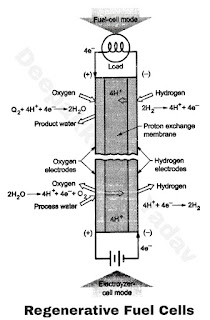Regenerative Fuel Cells (RFC)
- The Regenerative Fuel Cell (RFC) is a system that can operate in a closed loop and could serve as the basis of a hydrogen economy operating on renewable energy.
- Fuel cells generating electricity, heat, and water from hydrogen and oxygen would be used throughout the economy, powering factories, vehicles, and houses.
- The hydrogen would be generated from the electrolysis of water, splitting it into its constituent components of hydrogen and oxygen, using renewable energy sources such as wind, solar, or geothermal.
- Such a system would not require any specific type of fuel cell, but would need on infrastructure to deliver hydrogen to the many fuel cells in use. Little to no new technology required to implement a renewable-based system.
- However, there currently does not exist the infrastructure for hydrogen delivery.
- Also, the cost of electricity would be high, but will decrease as costs decrease for each of the components : Fuel cells, hydrogen storage and delivery, renewable energy collection, etc.
- Currently, there is a project led by NASA to develop an efficient and lightweight regenerative fuel cell system for use on board an airplane called the Helios that can fly at altitudes nearly 30000 m.
- The predecessor aircraft during the day and generate a supply of hydrogen that would be stored for use by the fuel cell overnigist. Such a system would then be capable of flights lasting many days.
- If the fuel cell is designed to operate also in reverse as an electrolyser, then electricity can be used to convert the water back into hydrogen and oxygen. (Refer Figure A).
- This dual function system is known as a reversible or unitised regenerative fuel cell (URFC). Lighter than a separate electrolyser and generator, a URFC is an excellent energy source in situations where weight is a concern.
- The regenerative fuel cell, coupled with lightweight hydrogen storage, had by far the highest energy density about 450 watt-hours per kilogram N ten times than of lead acid batteries and more than twice that forecast for any chemical for any chemical batteries.
- The Prototype Fuel cells have been used since the 1960s when they supplied on-board power for the Gemini and Apollo spacecraft.

